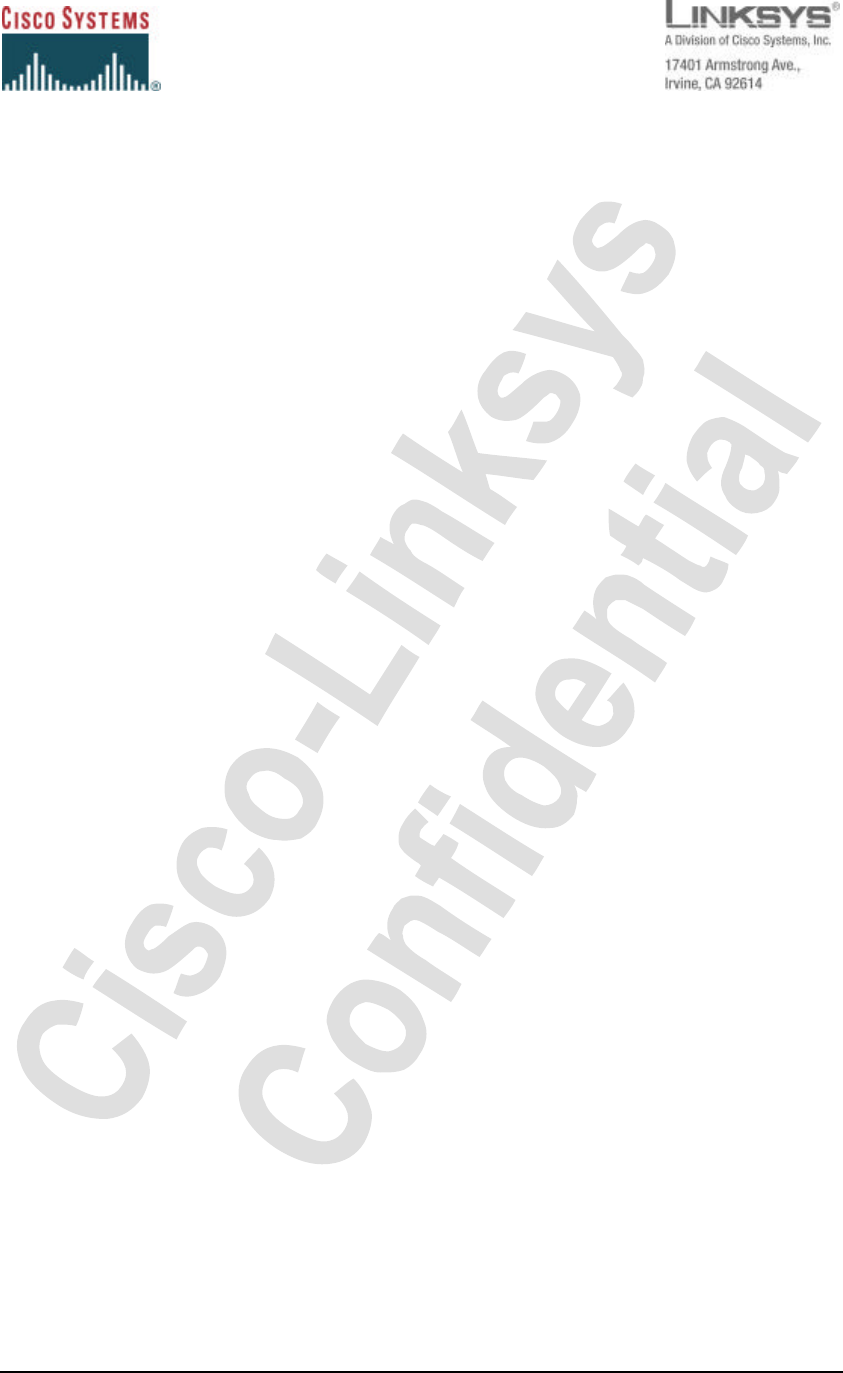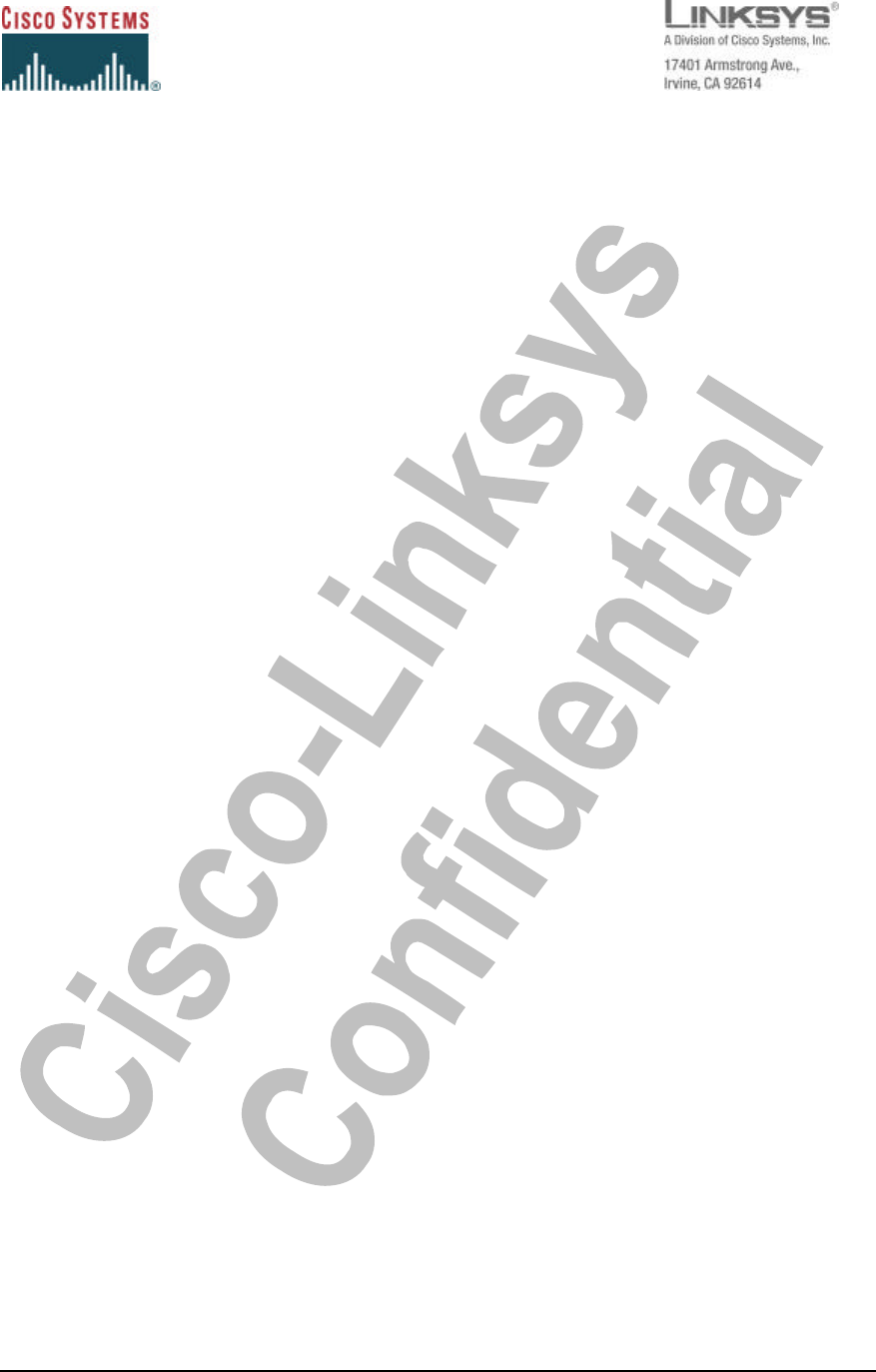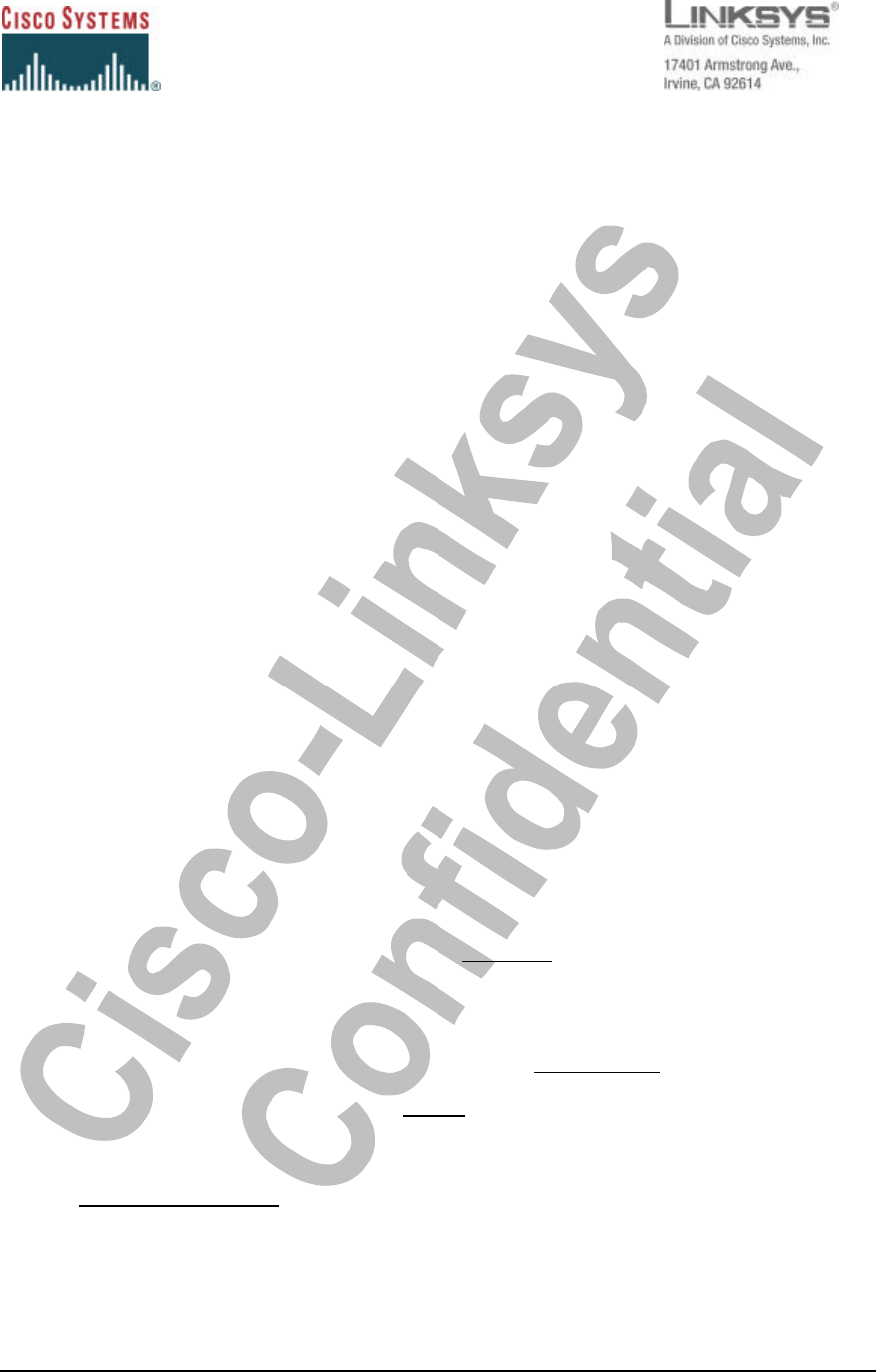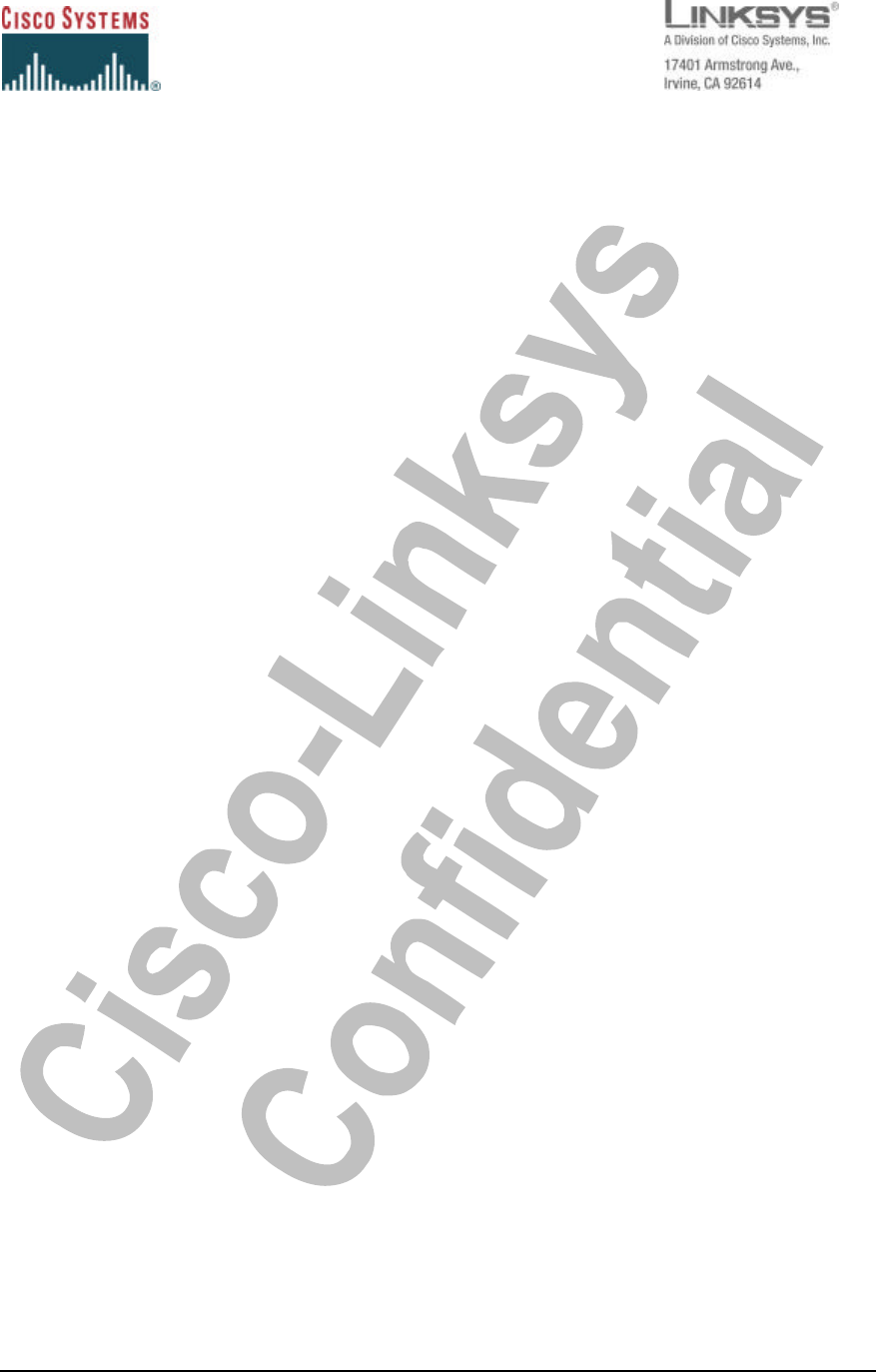LINKSYS WRV54GP2M Wireless 11G mini-PCI module User Manual Product Spec WRV54GP2M 040705
LINKSYS LLC Wireless 11G mini-PCI module Product Spec WRV54GP2M 040705
LINKSYS >
user manual

Cisco-Linksys Proprietary & Confidential Information
Cisco-Linksys
WRV54GP2M
Wireless-G mini PCI Adapter
Release 1.0
Date:
Author:

Cisco-Linksys Proprietary & Confidential Information
1
1. Introduction
Wireless-G is the upcoming 54Mbps wireless networking standard that's almost five times faster than the widely
deployed Wireless-B (802.11b) products found in homes, businesses, and public wireless hotspots around the
country — but since they share the same 2.4GHz radio band, Wireless-G devices can also work with existing
11Mbps Wireless-B equipment.
Wireless-G mini PCI Adapter has both standards built in. It is only used in embedded system made by Linksys
such as WRV54GP2 etc.
2. Product Specifications
Key Component
- 32bit 3.3V mini PCI Interface (Type B)
- MAC/BBS INPROCOMM IPN2220
Wireless Features
- Complies with IEEE 802.11g standards, and backwards compat ible with IEEE 802.11b products
- Operates in 2.4Ghz (2.412 ~ 2.462) frequency spectrum with throughput of up to 54 Mbps
- Support channels
u 11 channels (USA, Canada)
u 13 channels (Europe)
u 14 channels (Japan)
- Transmission rate:
u 802.11g: 54, 48, 36, 24, 18, 12, 9 and 6 Mbps
u 802.11b: 11, 5.5, 2 and 1 Mbps network
- Support 64-bit, 128-bit WEP encryption
- Support WPA
RF Spec
- Receive sensitivity
- 71dBm @ 54Mbps OFDM
- 85dBm @ 11Mbps CCK
- RF output power
Typical 15dBm @ 54Mbps OFDM
Typical 18dBm @ 11Mbps CCK

Cisco-Linksys Proprietary & Confidential Information
2
Federal Communication Commission Interference Statement
This equipment has been tested and found to comply with the limits for a Class B digital device,
pursuant to Part 15 of the FCC Rules. These limits are designed to provide reasonable
protection against harmful interference in a residential installation. This equipment generates,
uses and can radiate radio frequency energy and, if not installed and used in accordance with
the instructions, may cause harmful interference to radio communications. However, there is
no guarantee that interference will not occur in a particular installation. If this equipment
does cause harmful interference to radio or television reception, which can be determined by
turning the equipment off and on, the user is encouraged to try to correct the interference by
one of the following measures:
- Reorient or relocate the receiving antenna.
- Increase the separation between the equipment and receiver.
- Connect the equipment into an outlet on a circuit different from that
to which the receiver is connected.
- Consult the dealer or an experienced radio/TV technician for help.
This device complies with Part 15 of the FCC Rules. Operation is subject to the following two
conditions: (1) This device may not cause harmful interference, and (2) this device must
accept any interference received, including interference that may cause undesired operation.
FCC Caution: Any changes or modifications not expressly approved by the party responsible
for compliance could void the user's authority to operate this equipment.
IMPORTANT NOTE:
FCC Radiation Exposure Statement:
This equipment complies with FCC radiation exposure limits set forth for an uncontrolled
environment. This equipment should be installed and operated with minimum distance 20cm
between the radiator & your body.
This transmitter must not be co-located or operating in conjunction with any other antenna or
transmitter.
This device is intended only for OEM integrators under the following conditions:
1) The antenna must be installed such that 20 cm is maintained between the antenna and
users, and
2) The transmitter module may not be co-located with any other transmitter or antenna.
As long as 2 conditions above are met, further transmitter test will not be required. However,
the OEM integrator is still responsible for testing their end-product for any additional
compliance requirements required with this module installed (for example, digital device
emissions, PC peripheral requirements, etc.).
IMPORTANT NOTE: In the event that these conditions can not be met (for example certain
laptop configurations or co-location with another transmitter), then the FCC authorization is no
longer considered valid and the FCC ID can not be used on the final product. In these
circumstances, the OEM integrator will be responsible for re-evaluating the end product
(including the transmitter) and obtaining a separate FCC authorization.
End Product Labeling
This transmitter module is authorized only for use in device where the antenna may be
installed suc h that 20 cm may be maintained between the antenna and users (for example :
Wireless 11G mini-PCI module ). The final end product must be labeled in a visible area with
the following: “Contains TX FCC ID: Q87- WRV54GP2M ”.

Cisco-Linksys Proprietary & Confidential Information
3
The OEM integrator has to be aware not to provide information to the end user
regarding how to install or remove this RF module in the users manual of the end
product which integrate this module.
The users manual for OEM integrators must include the following information in a prominent
location “ IMPORTANT NOTE: To comply with FCC RF exposure compliance requirements,
the antenna used for this transmitter must be installed to provide a separation distance of at
least 20 cm from all persons and must not be co-located or operating in conjunc tion with any
other antenna or transmitter.
CyberTAN declared that WRV54GP2M is limited in CH1~11 by specified firmware
controlled in USA.
Canada (IC):
To prevent radio interference to the licensed service, this device is intended to be
operated indoors and away from windows to provide maximum shielding. Equipment
(or its transmit antenna) that is installed outdoors is subject to licensing.